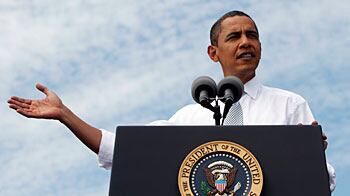
President Barack Obama’s poll numbers are slipping, and nowhere have they slipped more dramatically than in the Midwest, where his favorable ratings are now below 50 percent.
It’s hard to blame people in the Midwest, the heartland of American manufacturing, for having their doubts. It is increasingly apparent that the president and the Ivy League professors and Wall Street financiers who advise him, confronted with the greatest crisis to confront global industrial capitalism since the Great Depression, don’t understand how manufacturing works or how important it is to long-term American wealth and power.
Evidence for this depressing conclusion can be found in Obama’s July 14 speech in Warren, Mich., where he unveiled his administration’s “Graduation Initiative.” Along with earlier speeches before and after the election and the administration’s own actions, the president’s speech makes clear that the productive economy—manufacturing, agriculture, and resource extraction, along with the vast service-sector infrastructure they support—is something that this administration neither understands nor particularly cares about, unless it can be dressed up in feel-good “green” camouflage.
Let China and Japan and India and Germany lead the world in advanced manufacturing. We'll equip American workers with caulking guns.
“Obamanomics” to date has been a synthesis of the “new economy” theory of the 1990s—the U.S. should shed manufacturing for “knowledge jobs”—and the “green economy” fad of the 2000s. A green economy is not one in which every industry is clean and efficient, but rather one that makes a few iconic inputs like windmills for the renewable wind and solar power industries, which would not exist but for massive government subsidies and regulations. Combine the new economy and the green economy, and you have the perfect recipe for a post-industrial America that can feel good about not getting its hands dirty by making things anymore.
In his speech in Michigan, Obama hit both the new economy and green economy themes. First, the green economy:
“I want Michigan to build windmills and wind turbines and solar panels and biofuel plants and energy-efficient light bulbs and weatherize all our—because, Michigan, you know bad weather. [Laughter.] So you can be all on top of weatherizing. You need to weatherize. [Laughter.] I know about that in Chicago, too. [Laughter.]”
There you have it—the future of American manufacturing, according to the president, is not making machine tools, automobiles, aerospace, and consumer electronics, but rather making “windmills and wind turbines and solar panels and biofuel plants and energy-efficient light bulbs.” Never mind that the market for these is minor and mostly created by government mandates on utilities and government subsidies. Wind and solar combined amount to a mere 1 percent of U.S. electricity usage, and the Obama administration doesn’t think they can provide more than 20 percent by 2020, even with massive subsidies. Never mind, moreover, that we can import cheap wind turbines and solar panels from Europe and China. (The Obama administration, which opposed “Buy American” provisions in the stimulus bill, also opposes “green tariffs” on imports.)
Never mind. The green-collar jobs of the future, it seems, are in the government-subsidized boutique industry of windmills and solar panels, and also in low-productivity make-work jobs weatherizing existing and new buildings, no doubt with ample federal subsidies, as well. Let China and Japan and India and Germany lead the world in advanced manufacturing. We’ll equip American workers with caulking guns.
So much for the green economy. Obama then moves on to the other part of Obamanomics—the new economy, familiar from the 1990s: “But we also have to ensure that we’re educating and preparing our people for the new jobs of the 21st century. We’ve got to prepare our people with the skills they need to compete in this global economy. [Applause.]” The president continues: “So we've already taken some steps that are building the foundation for a 21st century education system here in America, one that will allow us to compete with China and India and everybody else all around the world.” (Emphasis mine.)
Obama surely did not intend to insult America’s industrial workers. But that’s exactly what he did, by implying that if American workers lose their jobs to Chinese and Indian workers, their own lack of education is to blame. Not the short-term calculations of greedy shareholders who pressure U.S. multinational companies into shuttering factories in the U.S. and opening them in other countries that offer subsidies, manipulated exchange rates, or lax environmental laws, or poor workers forbidden to form free labor unions. No, if a U.S. company outsources production to China and India, the president of the United States implies, it can only be because their workers are better educated than ours.
Never fear, though. Obama will send the former industrial workers to school, to help raise them to the level of today’s Chinese peasants on assembly lines.
Having proven that he (or his speechwriters) does not understand the global industrial economy of the 21st century, the president then rewrites the history of 19th and 20th century industrial America to support the pleasing idea that more diplomas translated into economic growth in the past and can do so again, in the absence of more intrusive national industrial strategies:
“Time and again, when we placed our bet for the future on education, we have prospered as a result—by tapping the incredible innovative and generative potential of a skilled American work force. That’s what happened when President Lincoln signed into law legislation creating the land grant colleges, which not only transformed higher education, but also our entire economy. That’s what took place when President Roosevelt signed the GI Bill, which helped educate a generation and ushered in an era of unprecedented prosperity. That was the foundation for the American middle class."
Although he is a lawyer and community activist by background, Obama is now the leader of the greatest industrial nation in the world, and there is no excuse for him to promote misleading nonsense like this. It is absurd to say that “a skilled American work force” by itself played more than a supporting part in the success of U.S. industrial capitalism in the last two centuries. In the post-Lincoln era, the newly created land grant colleges were important—but far less important than high tariffs, which protected American infant industries from foreign competition, and the massive federal subsidies of the railroads, in the form of land grants. During the post-New Deal era, the GI Bill, though significant, was far less important than massive federal infrastructure developments like the TVA, the development of aerospace and computer technology by Defense Department procurement and R&D policies, the high level of consumer demand created by unionized labor, and the lack of serious European and Asian industrial competition between World War II and the 1970s.
If Obama really wanted to emulate Lincoln and Roosevelt, he would not be telling Americans that their future lies in windmills and diploma mills. He would learn from the example of the agricultural A&Ms and of Defense Department research during the Cold War of the need for massive, permanent increases in federal R&D in basic science and technology—not incentives in the tax code for Wall Street venture capitalists to fund research, but directly funded government research.
If he wanted to promote U.S. industry as Lincoln and Roosevelt did, he would favor “Buy American” domestic-content legislation and other policies to reward the onshoring of production in American borders, by domestic and foreign companies alike, rather than outsourcing of American industries. Instead of peddling the fashionable but silly idea of a boutique “green economy” composed of windmills and rooftop solar power, the president would favor a “clean economy” based on efficiency and reductions in greenhouse-gas emissions from any workable technology, including possibly clean carbon and nuclear energy.
This assumes, of course, that Obama wants to be an industrial president, like Lincoln and Roosevelt, rather than the president of a post-industrial nation with an economy divided between rentiers and menial service-sector proles. If he continues on his present course, ignoring the intensifying global competition for manufacturing while telling Americans comforting fairy tales about windmills and diploma mills, then Barack Obama, the postindustrial president, may be a post-president in 2013.
Michael Lind is the editor of New American Contract at the New America Foundation in Washington, D.C., and the author of The American Way of Strategy. He has been a staff writer or senior editor at the New Yorker, Harper’s magazine, the New Republic, and the National Interest.






